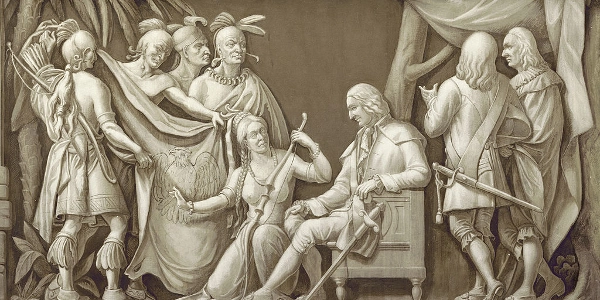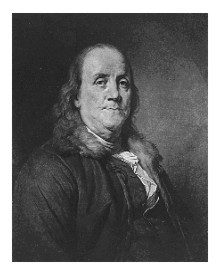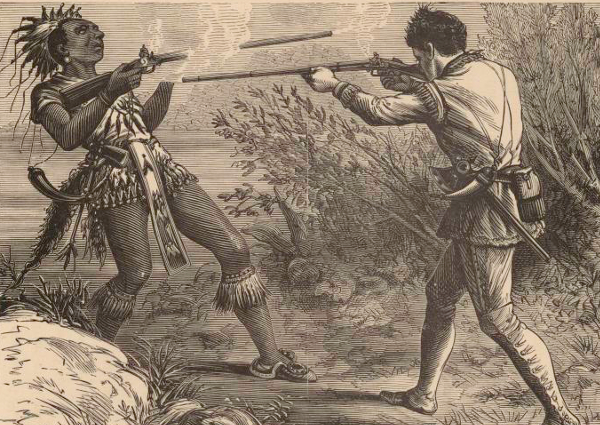Sponsor this page for $150 per year. Your banner or text ad can fill the space above.
Click here to Sponsor the page and how to reserve your ad.
-
Timeline
1720 Detail
January - September, 1720 - Stock prices in the Mississippi Company of John Law with exclusive trading rights in the New France colony of Louisiana and the Mississippi River collapses in the Mississippi Bubble.

On September 6, 1717, John Law, under the French Mississippi Company, sometimes known as the Company of the West got a twenty-five year monopoly to develop Louisiana. One of its first tasks was to develop the city of New Orleans, which they accomplished when Governor Bienville chose its site on May 7, 1718. It met John Law's liking, even though there was some disagreement that going further north, to the area of Baton Rouge, might have been more suitable.
John Law had been persistent in fostering the notion that the area of New France in Louisiana, as well as parts of Mississippi and Alabama were rich in silver and gold, and with the French economy in shambles, they were looking for a way to boost its treasury. Bienville, past and future governor of the territory, and his brother, d'Iberville, had been great at establishing French presence in the area since 1698, but had not been able to develop Louisiana as much as they had Biloxi and Mobile.
However, John Law was an Edinburgh, Scotland dreamer and gambler who liked women and economic theory. He had come to France in 1714 to meet with his friend, the nephew of King Louis XIV, the Duke of Orleans. When the Duke of Orleans became the regent of France upon the death of the current King, this due to the fact that the heir, Louis XV, was a minor, France relied on John Law to assist in solving France's financial affairs.
John Law approached that problem by opening a bank, Bank Generale, later Bank Royale, that issued paper money backed by silver and gold. He approached the problem of the colony of Louisiana in a different manner, founding a company in August 1717, Compagnie d'Occident, the Company of the West, and better known as the French Mississippi Company. The French government gave the Mississippi Company complete control over trade in the Louisiana colony and some of the Canadian colonial territory. For Louisiana, it would be trade in precious metals. The colony stretched for three thousand miles; it included the states of Louisiana, Mississippi, Arkansas, Illinois, Iowa, Wisconsin, Minnesota, and into parts of Canada.
In hindsight, it seemed a risky venture for the government of France to put that much trust in one man's vision, and a Scottish man at that, and for twenty-five years. Law could appoint the governor (he chose John Baptiste Le Moyne, Sier de Bienville again), make land grants, and was charged with the importation of six thousand settlers and three thousand slaves. He sold shares in the company for cash and state bonds. The lure of silver and gold drew in many investors. Bienville warned France of the undertaking, however, as he did not think that Louisiana was rich in gold and silver, and that the colony should focus on agriculture. The French government chose to believe Law instead.
How the Mississippi Company Operated
The overall scheme of the Mississippi Company had solid underpinnings, but Law became greedy and expansive all at once, even before the Company could get underway in Louisiana. In September 1918, he bought a monopoly in trading tobacco with Africa, then gained control of trade with China and the East Indies. All this required a name change, the Mississippi Company was now only a small part of his growing empire; it would be known as the Compagnie des Indes, although most still used the old name. In essence, Law now controlled all trade between France and the rest of the world outside Europe.
Add to that, the company got the right to mint coins for France, and purchased the rights to collect French taxes. By January 1720, John Law had become the Controller General and Superintendant General of Finance of France. All of this activity should have brought questions into how the Mississippi Company could handle all of that, but instead it convinced investors, some through Law's exaggerations, to drive up the stock price of the company as they saw Law in control of a vast and growing empire. In January 1719, the shares had sold for 500 livres; by December, they were selling for 10,000 livres. It created and coined the term millionaires for many of the early investors.
While most of the efforts of the Mississippi Company surround its rise and fall; there were certain achievements in Louisiana itself. Near its inception in 1718, there were only seven hundred Europeans living in Louisiana; Law encouraged eight hundred new settlers to come by the end of that year to emigrate, many from Germany, the Alsace, and Switzerland. Additional colonists were brought from more problematic sources; freed prisoners were solicited in three shipments before the French government shut that program down.
However, it does not take a genius to see that a company that large would have trouble keeping its financial ducks in a row. And Law's issuance of additional bank notes to fund additional stock purchases was going to prove his downfall.

The Mississippi Bubble Bursts
Stock prices began to fall in January 1720. Investors were taking profits and taking them in gold. Law attempted to stop the sell-off by restricting gold payments to 100 livres. The rest would come in paper money issued by the Bank Royale, which was now made legal tender. The bank promised to exchange its notes for the going 10,000 livres per share.
Suddenly the money supply in France doubled; inflation rose to twenty-three percent per month. And for the Mississippi Company, the value of its shares dropped off a cliff. While many called it a bubble bursting, which was accurate, it was actually a financial calamity. In December 1720, a share cost 1,000 livres. Law's enemies used the confusion to take control of the company. By September 1721, a share was down to its original price, 500 livres.
There are many who believe that that original purpose of the Mississippi Company was legitimate with potential, but that Law's financial arrangements were wrong. It would take France eighty years to reintroduce paper currency into its economy.
Image above: Montage (left) Painting of Jean-Baptiste Le Moyne de Bienville, unknown date or author. Courtesy Wikipedia Commons; (right) painting of John Law, unknown date, Casimir Balthazar. Courtesy Wikipedia Commons. Image Below: Drawing of John Law Camp, Biloxi, unknown date and author. Courtesy "Africans in Colonial Louisiana," Gwendolyn Midlo Hall, American Council of Learned Societies via Wikipedia Commons. Info Source: "John Law and the Mississippi Bubble," 2001, Jon Moen, https://mshistorynow.mdah.ms.gov; royaltoursneworleans.com; Wikipedia Commons.

History Photo Bomb

On September 6, 1717, John Law, under the French Mississippi Company, sometimes known as the Company of the West got a twenty-five year monopoly to develop Louisiana. One of its first tasks was to develop the city of New Orleans, which they accomplished when Governor Bienville chose its site on May 7, 1718. It met John Law's liking, even though there was some disagreement that going further north, to the area of Baton Rouge, might have been more suitable.
John Law had been persistent in fostering the notion that the area of New France in Louisiana, as well as parts of Mississippi and Alabama were rich in silver and gold, and with the French economy in shambles, they were looking for a way to boost its treasury. Bienville, past and future governor of the territory, and his brother, d'Iberville, had been great at establishing French presence in the area since 1698, but had not been able to develop Louisiana as much as they had Biloxi and Mobile.
However, John Law was an Edinburgh, Scotland dreamer and gambler who liked women and economic theory. He had come to France in 1714 to meet with his friend, the nephew of King Louis XIV, the Duke of Orleans. When the Duke of Orleans became the regent of France upon the death of the current King, this due to the fact that the heir, Louis XV, was a minor, France relied on John Law to assist in solving France's financial affairs.
John Law approached that problem by opening a bank, Bank Generale, later Bank Royale, that issued paper money backed by silver and gold. He approached the problem of the colony of Louisiana in a different manner, founding a company in August 1717, Compagnie d'Occident, the Company of the West, and better known as the French Mississippi Company. The French government gave the Mississippi Company complete control over trade in the Louisiana colony and some of the Canadian colonial territory. For Louisiana, it would be trade in precious metals. The colony stretched for three thousand miles; it included the states of Louisiana, Mississippi, Arkansas, Illinois, Iowa, Wisconsin, Minnesota, and into parts of Canada.
In hindsight, it seemed a risky venture for the government of France to put that much trust in one man's vision, and a Scottish man at that, and for twenty-five years. Law could appoint the governor (he chose John Baptiste Le Moyne, Sier de Bienville again), make land grants, and was charged with the importation of six thousand settlers and three thousand slaves. He sold shares in the company for cash and state bonds. The lure of silver and gold drew in many investors. Bienville warned France of the undertaking, however, as he did not think that Louisiana was rich in gold and silver, and that the colony should focus on agriculture. The French government chose to believe Law instead.
How the Mississippi Company Operated
The overall scheme of the Mississippi Company had solid underpinnings, but Law became greedy and expansive all at once, even before the Company could get underway in Louisiana. In September 1918, he bought a monopoly in trading tobacco with Africa, then gained control of trade with China and the East Indies. All this required a name change, the Mississippi Company was now only a small part of his growing empire; it would be known as the Compagnie des Indes, although most still used the old name. In essence, Law now controlled all trade between France and the rest of the world outside Europe.
Add to that, the company got the right to mint coins for France, and purchased the rights to collect French taxes. By January 1720, John Law had become the Controller General and Superintendant General of Finance of France. All of this activity should have brought questions into how the Mississippi Company could handle all of that, but instead it convinced investors, some through Law's exaggerations, to drive up the stock price of the company as they saw Law in control of a vast and growing empire. In January 1719, the shares had sold for 500 livres; by December, they were selling for 10,000 livres. It created and coined the term millionaires for many of the early investors.
While most of the efforts of the Mississippi Company surround its rise and fall; there were certain achievements in Louisiana itself. Near its inception in 1718, there were only seven hundred Europeans living in Louisiana; Law encouraged eight hundred new settlers to come by the end of that year to emigrate, many from Germany, the Alsace, and Switzerland. Additional colonists were brought from more problematic sources; freed prisoners were solicited in three shipments before the French government shut that program down.
However, it does not take a genius to see that a company that large would have trouble keeping its financial ducks in a row. And Law's issuance of additional bank notes to fund additional stock purchases was going to prove his downfall.

The Mississippi Bubble Bursts
Stock prices began to fall in January 1720. Investors were taking profits and taking them in gold. Law attempted to stop the sell-off by restricting gold payments to 100 livres. The rest would come in paper money issued by the Bank Royale, which was now made legal tender. The bank promised to exchange its notes for the going 10,000 livres per share.
Suddenly the money supply in France doubled; inflation rose to twenty-three percent per month. And for the Mississippi Company, the value of its shares dropped off a cliff. While many called it a bubble bursting, which was accurate, it was actually a financial calamity. In December 1720, a share cost 1,000 livres. Law's enemies used the confusion to take control of the company. By September 1721, a share was down to its original price, 500 livres.
There are many who believe that that original purpose of the Mississippi Company was legitimate with potential, but that Law's financial arrangements were wrong. It would take France eighty years to reintroduce paper currency into its economy.
Image above: Montage (left) Painting of Jean-Baptiste Le Moyne de Bienville, unknown date or author. Courtesy Wikipedia Commons; (right) painting of John Law, unknown date, Casimir Balthazar. Courtesy Wikipedia Commons. Image Below: Drawing of John Law Camp, Biloxi, unknown date and author. Courtesy "Africans in Colonial Louisiana," Gwendolyn Midlo Hall, American Council of Learned Societies via Wikipedia Commons. Info Source: "John Law and the Mississippi Bubble," 2001, Jon Moen, https://mshistorynow.mdah.ms.gov; royaltoursneworleans.com; Wikipedia Commons.







